A month or so ago I received an invitation to attend a special farewell ceremony for Professor Emeritus Amos Kloner of Bar Ilan University. Already in his mid-seventies, Prof Kloner finished his lecturing last semester and was being honoured for his work at one of the most famous places he helped bring to life: Beit Guvrin – Maresha.
I had visited Beit Guvrin – Maresha on my 12th grade graduation trip to Israel and haven’t been back to explore since, aside from a short visit to the Roman amphitheatre located nearby (HERE). And so it was on a pleasant Thursday afternoon that I boarded a bus with other university members and we made our way to the national park. Because of Prof Kloner’s renown, the event was co-hosted by the Israel Antiquities Authority and the Israel Nature and Parks Authority in conjunction with BIU. Within the park we followed the evening’s mapped itinerary, starting with the fascinating ancient underground columbarium, or dovecote, with its capacity for thousands of pigeons or doves.
Due to the region’s soft, chalky bedrock, there are hundreds and hundreds of caves – some natural and the others man-made. To give a brief synopsis of the local history, a fortified city by the name of Maresha is Biblically mentioned as a Jewish city until the times of the Babylonian king Nebuchadnezzar II who exiled its inhabitants. Abandoned Maresha was then occupied by the Edomites until the time of Alexander the Great when the city became the home of retired Greek soldiers. Enter the Maccabean Revolt, Pompey, Julius Caesar and then Herod and the city was destroyed in the power struggle.
Still in the Roman period, the small Jewish settlement of Beit Guvrin nearby became a regional replacement of Maresha and was named Eleutheropolis by the Romans after being conquered by Vespasian. Uncharacteristic of Holy Land cities, the ancient history ends with the Romans, save a few scattered instances of settlement throughout the following two millennia. As we climbed out of the columbarium I bumped into future tour guide Haike Winter and her friend – always fun to see familiar faces in unlikely places.
The next site on the map was the water cistern and olive press, both carved into the soft rock underground, where we heard a brief lecture on theories regarding Greek influence and involvement during the time of Alexander the Great. Climbing out, we continued on to mount Tel Maresha, where a guest lecturer hailing from Caesarea came to speak. There we stood gazing at the lay of the land, listening to the pastoral sounds of a flock of sheep passing down below.
The next place we visited was the famous Sidonian burial cave with its imaginative paintings, known as the Apollophanes Cave, a place I remember from my trip in 2008.
I was overjoyed to see the painting of a wild boar alongside other wild animals such as antelopes, giraffes, elephants and more. Ever since my run-ins with the ferocious and savage swine in both Nachal Kziv and Nachal Ga’aton I have been excited to see inanimate representations in ancient art.
From the Sidonian burial cave we boarded the buses to visit the famous Bell Caves where the ceremonially academic evening of lectures was to take place. Food and beverages were served yet I preferred to photograph jackdaws and to then visit the Bell Caves before the crowds arrived. During my 2008 visit we neglected to visit the Bell Caves so I was duly impressed to see the huge chambres, hewn from soft chalk, to be used mainly as quarries during the Byzantine era.
There were a few other people wandering around the caves as well and I used them in my pictures for perspective, to gauge the height of the large bell-shaped caves. When I had completed my subterranean tour I joined the rest of our group at a nearby cave where chairs and a screen were set up for lectures. Settling down next to my friend Itamar, I listened to the speeches and took notes on what everyone spoke about. Dr Tsvika Tsuk of the Israel Nature and Parks Authority spoke about being a soldier and finding a sarcophagus, and then the story of the recent victory getting UNESCO to recognise Beit Guvrin – Maresha as a World Heritage Site.
Dr Ian Stern of Archaeological Seminars told us about interesting findings such as items used for magic and ancient cultist practices. Dr Adi Erlich from Haifa University showed us slideshows of clay idols or figurines found locally, putting emphasis on one particular idol of Cybele – unusual to see in the Holy Land as Cybele was an Asia Minor deity. Prof Esther Eshel from BIU provided us with knowledge on ancient documents found inscribed on clay tablets while our department head Prof Boaz Zissu gave us a general historical and archaeological overview about Maresha, showing us fascinating pictures from the early 1900’s.

Inside the Sidonian burial cave from the early 1900’s (cropped photo: Library of Congress)
Prof Gideon Avni of the Israel Antiquities Authority told us stories of grave robbers, destruction and discoveries of graves in the necropolis and then the star of the evening, Prof Amos Kloner, got up to give his address. With that the evening concluded and we took our bus back to Bar Ilan University for a good night’s sleep.

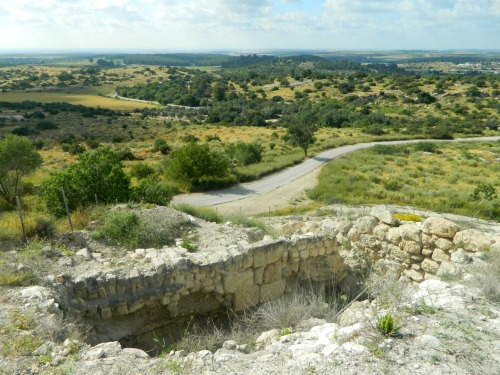
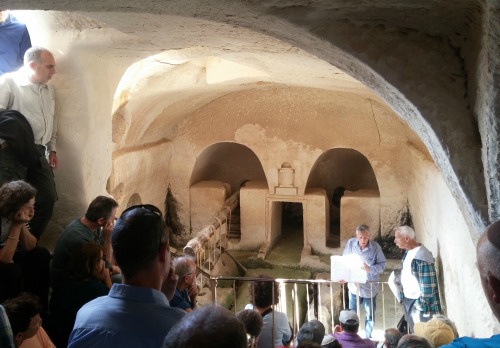
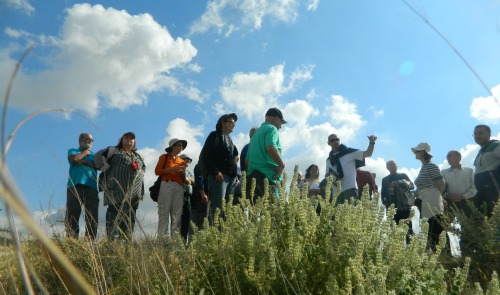
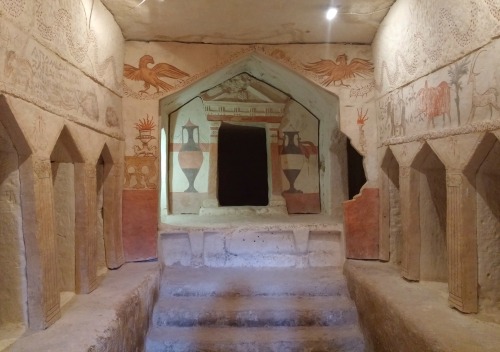


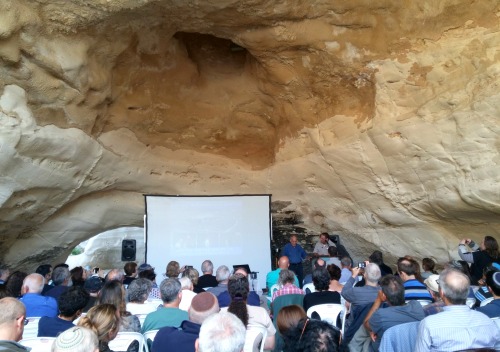
how beautiful and precious!
Thank you! I’m glad you enjoyed!
[…] by my friend Itamar about the Khirbet Arai archaeological dig in the Judean lowlands, not far from Beit Guvrin and Kiryat Gat. I traveled down to Beit Shemesh the day prior and we went out to see The Jungle […]
[…] spotted with hay bales, we spotted with greater ease the iconic apse of the Church of St Anne at Beit Guvrin-Maresha less than four kilometres away. Wrapping up our tour of Tel Burna, we trekked back down the hill […]
[…] Late Sunday afternoon I took a train down to Kiryat Gat where I was picked up by the dig director, Dr Orit Peleg-Barkat, and taken to the base camp of the excavation, Kibbutz Beit Guvrin. I had written twice about sites at Beit Guvrin, which can be seen HERE and HERE. […]
[…] August, I took a short trip to the Crusader fortress that I had missed in my previous trips to Beit Guvrin. Since I was staying at the nearby Kibbutz Beit Guvrin, I did not have far to go and set out on my […]
[…] a mini-bus ride from the university to the site itself, located just a few kilometres northeast of Beit Guvrin-Maresha, and […]
[…] department, we returned once again to Tel Goded. Located in the Judean lowlands, not far from Beit Guvrin and Tel Burna, the tel hosts mountaintop settlements ranging from the Bronze Era all the way until […]